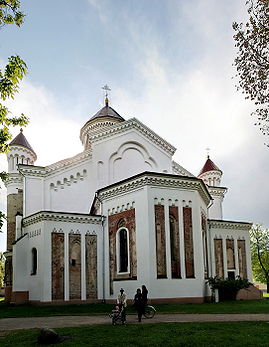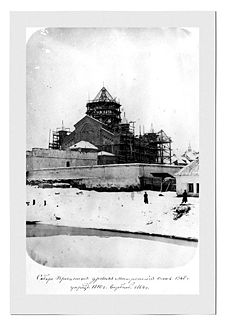
Cathedral of the Theotokos, Vilnius
Encyclopedia


Lithuania
Lithuania , officially the Republic of Lithuania is a country in Northern Europe, the biggest of the three Baltic states. It is situated along the southeastern shore of the Baltic Sea, whereby to the west lie Sweden and Denmark...
.
The cathedral was built during the reign of the Grand Duke Algirdas
Algirdas
Algirdas was a monarch of medieval Lithuania. Algirdas ruled the Grand Duchy of Lithuania from 1345 to 1377, which chiefly meant monarch of Lithuanians and Ruthenians...
in 1346. It was constructed by Kiev
Kiev
Kiev or Kyiv is the capital and the largest city of Ukraine, located in the north central part of the country on the Dnieper River. The population as of the 2001 census was 2,611,300. However, higher numbers have been cited in the press....
an architects with the blessing of Saint Alexius
Alexius, Metropolitan of Moscow
Saint Alexius was Metropolitan of Kiev and all Russia , and presided over the Moscow government during Dmitrii Donskoi's minority....
Metropolitan of Kiev and all Rus
Kievan Rus'
Kievan Rus was a medieval polity in Eastern Europe, from the late 9th to the mid 13th century, when it disintegrated under the pressure of the Mongol invasion of 1237–1240....
in 1348.
The Cathedral of the Theotokos
Theotokos
Theotokos is the Greek title of Mary, the mother of Jesus used especially in the Eastern Orthodox, Oriental Orthodox, and Eastern Catholic Churches. Its literal English translations include God-bearer and the one who gives birth to God. Less literal translations include Mother of God...
is one of the most ancient churches of Vilnius
Vilnius
Vilnius is the capital of Lithuania, and its largest city, with a population of 560,190 as of 2010. It is the seat of the Vilnius city municipality and of the Vilnius district municipality. It is also the capital of Vilnius County...
, built before the christianization of Lithuania
Christianization of Lithuania
The Christianization of Lithuania – Christianization of the Grand Duchy of Lithuania that took place in 1387, initiated by the King of Poland and Grand Duke of Lithuania Jogaila and his cousin Vytautas, that signified the official adoption of Christianity by Lithuanians, one of the last pagan...
when the Grand Duchy of Lithuania
Grand Duchy of Lithuania
The Grand Duchy of Lithuania was a European state from the 12th /13th century until 1569 and then as a constituent part of Polish-Lithuanian Commonwealth until 1791 when Constitution of May 3, 1791 abolished it in favor of unitary state. It was founded by the Lithuanians, one of the polytheistic...
was the last pagan
Paganism
Paganism is a blanket term, typically used to refer to non-Abrahamic, indigenous polytheistic religious traditions....
state in Europe. It became an important spiritual centre for the growing Christian population of the duchy. In 1495 the marriage between Aleksandras of Lithuania
Alexander Jagiellon
Alexander of the House of Jagiellon was the Grand Duke of Lithuania and later also King of Poland. He was the fourth son of Casimir IV Jagiellon...
and Yelena of Muscovy
Helena of Moscow
Helena Ivanovna of Moscow was a Grand Duchess of Lithuania and Queen of Poland as a wife of king of Poland Alexander Jagiellon.-Biography:...
(Ivan III
Ivan III of Russia
Ivan III Vasilyevich , also known as Ivan the Great, was a Grand Prince of Moscow and "Grand Prince of all Rus"...
's daughter) was held in the cathedral in the presence of Saint Macarius
Saint Macarius
Saint Macarius may refer to:* Macarius of Egypt, also known as "Macarius the Great" or "Macarius the Elder" 4th century Egyptian monk* Macarius of Alexandria Saint Macarius may refer to:* Macarius of Egypt, also known as "Macarius the Great" or "Macarius the Elder" 4th century Egyptian monk*...
. It was there that Yelena was buried in 1513.
After the conversion of Lithuania
Christianization of Lithuania
The Christianization of Lithuania – Christianization of the Grand Duchy of Lithuania that took place in 1387, initiated by the King of Poland and Grand Duke of Lithuania Jogaila and his cousin Vytautas, that signified the official adoption of Christianity by Lithuanians, one of the last pagan...
to Roman Catholicism, the Orthodox cathedral was protected by princes Konstanty Ostrogski
Konstanty Ostrogski
Konstanty Iwanowicz Ostrogski was a Lithuanian duke of slavonic origin and a Grand Hetman of Lithuania since September 11, 1497, until his death. As a speaker of the Ruthenian language he is considered to be one of the precursors of the Belarusian language and a national hero in Belarus.He...
and Konstanty Wasyl Ostrogski
Konstanty Wasyl Ostrogski
Konstanty Wasyl Ostrogski was a Lithuanian prince, starost of Volodymyr-Volynskyi, marshal of Volhynia and voivode of the Kiev Voivodeship, Polish–Lithuanian Commonwealth. He got married on January 1553 in Tarnów...
, who restored it after the collapse of the dome in 1506. After their deaths, the cathedral was taken over by the Greek-Catholic church in 1609 and was rebuilt in a style typical of the region.
In 1748 the cathedral was abandoned after a major fire and the building was used for various other purposes. It was reconstructed in the Baroque style in 1785. The cathedral was once again destroyed by Russian army during the Kościuszko Uprising
Kosciuszko Uprising
The Kościuszko Uprising was an uprising against Imperial Russia and the Kingdom of Prussia led by Tadeusz Kościuszko in Poland, Belarus and Lithuania in 1794...
. In 1808 a local prelate sold the neglected building to the Vilnius University
Vilnius University
Vilnius University is the oldest university in the Baltic states and one of the oldest in Eastern Europe. It is also the largest university in Lithuania....
, which had the building thoroughly modernised in 1822 in the Neoclassical style
Neoclassical architecture
Neoclassical architecture was an architectural style produced by the neoclassical movement that began in the mid-18th century, manifested both in its details as a reaction against the Rococo style of naturalistic ornament, and in its architectural formulas as an outgrowth of some classicizing...
by Karol Podczaszyński
Karol Podczaszynski
Karol Podczaszyński was a Polish-Lithuanian architect, a representative of the neoclassical architecture and a professor of the Imperial University of Vilna, as well as one of the pioneers of industrial design....
. After that, the building hosted an anatomical theatre
Anatomical theatre
An anatomical theatre was an institution used in teaching anatomy at early modern universities.The theatre was usually a room of roughly amphitheatrical shape, in the centre of which would stand the table on which the dissections of human or animal bodies took place...
, library and other university facilities for half a century.
The old Orthodox cathedral was confiscated and transferred to the Russian Orthodox Church
Russian Orthodox Church
The Russian Orthodox Church or, alternatively, the Moscow Patriarchate The ROC is often said to be the largest of the Eastern Orthodox churches in the world; including all the autocephalous churches under its umbrella, its adherents number over 150 million worldwide—about half of the 300 million...
on the initiative of count Mikhail Nikolayevich Muravyov
Mikhail Nikolayevich Muravyov-Vilensky
Count Mikhail Nikolayevich Muravyov was one of the most reactionary Russian imperial statesmen of the 19th century...
and his brother during the Russification campaign. The Russian architect Nikolai Chagin
Nikolai Chagin
Nikolay Mikhailovich Chagin was a Russian architect active primarily in Vilnius and the Crimea. He took part in the Siege of Sevastopol and served as Vilno's main architect for 38 years. Chagin mastered the Byzantine Revival and several other revivalist styles, often blending them at will...
was responsible for its reconstruction from 1865 until 1868 in a style imitating medieval Georgian architecture. Why such a style was applied is not clear.
St. Tikhon (Belavin)
Tikhon of Moscow
Saint Tikhon of Moscow , born Vasily Ivanovich Bellavin , was the 11th Patriarch of Moscow and All Russia of the Russian Orthodox Church during the early years of the Soviet Union, 1917 through 1925.-Early life:...
, then Archbishop of Vilnius, presided over the cathedral and Orthodox Christians of Lithuania between 1913 and the occupation of Lithuania by the German troops in 1915. Most of the Russian Orthodox clergy left with the retreating Russian army.
The cathedral of the Theotokos was damaged during the Second World War
Eastern Front (World War II)
The Eastern Front of World War II was a theatre of World War II between the European Axis powers and co-belligerent Finland against the Soviet Union, Poland, and some other Allies which encompassed Northern, Southern and Eastern Europe from 22 June 1941 to 9 May 1945...
but was restored in 1948, although its renovations were not completed until 1957. Today the cathedral belongs to the Russian Orthodox Church and was once again renovated in 1998. Its services are attended mostly by ethnic Russian
Russians
The Russian people are an East Slavic ethnic group native to Russia, speaking the Russian language and primarily living in Russia and neighboring countries....
and Belarusian
Belarusians
Belarusians ; are an East Slavic ethnic group who populate the majority of the Republic of Belarus. Introduced to the world as a new state in the early 1990s, the Republic of Belarus brought with it the notion of a re-emerging Belarusian ethnicity, drawn upon the lines of the Old Belarusian...
residents of Vilnius.

